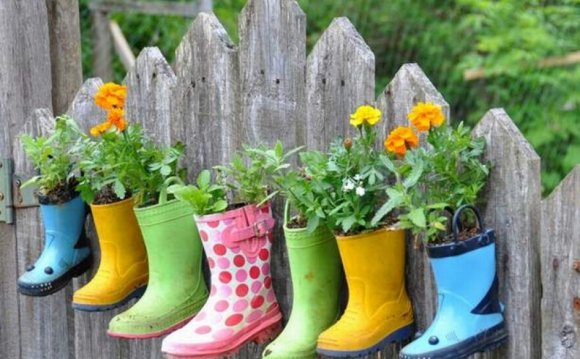
Spring is a good time to begin growing and digging, although planning can take place before the snow melts. Gardeners spend most of the summer watering, weeding, and watching young plants grow. Fall is a good time to plant trees, shrubs, bulbs, and some perennials.
1. Get an idea. Is this going to be a vegetable garden? An herb garden? A flower garden? If you choose to grow flowers, do you want annuals, which you must replant each year but which give color most of the summer? Or do you prefer perennials, which have a shorter bloom time but come back year after year? You can mix any of the above - after all, it's your garden. Just one bit of advice: Start small. 'Tis better to succeed just a little, than to fail grandly.
2. Pick a place. Almost all vegetables and most flowers need about six hours of full sun each day. Spend a day in your chosen spot and watch how the sun moves across the space. It might receive more sun than you think. But don't despair if your lot is largely sunless; many plants tolerate shade. Check plant tags or ask the staff at your local garden center to find out how much sun a plant requires.
Put the garden where you can't ignore its pleas for attention - outside the back door, near the mailbox, by the window you stare out when you dry your hair. Place it close enough to a water spigot that you won't have to drag the hose to the hinterlands.
3. Clear the ground. Get rid of the sod covering the area you plan to plant. If you want quick results, you can dig it out, but it's easier to smother it with newspaper. A layer of five sheets is usually thick enough; double that if your lawn is Bermudagrass or St. Augustine grass. Spread a 3-inch layer of compost (or combination of potting soil and topsoil) on the newspaper and wait. It'll take about four months for the compost and paper to decompose.
If you don't want to wait or if the area is covered with weeds such as creeping Charlie (Glechoma hederacea), you're better off digging the sod out.
4. Improve the soil. Invariably, soil needs a boost. The solution is simple: organic matter. Add a 2- to 3-inch layer of compost, decayed leaves, dry grass clippings, or old manure. If you dig soil (see Step 5), till the organic matter into the soil. If you decide not to dig or are working with an established bed you can't dig, leave the organic matter on the surface and it will work its way into the soil in a few months.
To learn more about your soil, have a soil test done through your county cooperative extension office. They'll lead you through the procedure: how much soil to send from which parts of the garden, and the best time to obtain samples. Expect a two-week wait for their findings, which will tell you what your soil lacks and how to amend it.
5. Dig or don't. Digging loosens the soil so roots can penetrate more easily. But digging when the soil is too wet or too dry can ruin its structure. Dig only when the soil is moist enough to form a loose ball in your fist, but dry enough to fall apart when you drop it. Use a spade or spading fork to gently turn the top 8 to 12 inches of soil, mixing in the organic matter from Step 4. In vegetable gardens and beds of annual flowers, turn the soil only once a year in the spring before you plant.
The traditional method of preparing a bed for perennial flowers is to double-dig. Double-digging involves removing the top 8-12 inches of soil (usually from one small area at a time), loosening and working organic matter into the newly exposed 8- to 12-inch layer of soil, replacing the top layer, then working organic matter into the top layer. It's a lot of work, but it can make a big difference in how well perennials grow.
Plants and Care
6. Pick your plants. Some people pore over catalogs for months; some people head to the garden center and buy what wows them. Either method works if you choose plants adapted to your climate, your soil, and the amount of sunlight in your garden. You can even surf the Internet for plants to purchase. Here are a few easy-to-grow plants for beginners. Annual: cosmos, marigolds, impatiens, geraniums, Calendula, sunflowers, and zinnias. Perennials: Russian sage, lamb's-ears, black-eyed Susans, purple coneflowers, phlox, pansies, and daylilies. Vegetables: lettuce, peppers, tomatoes, and cucumbers.















